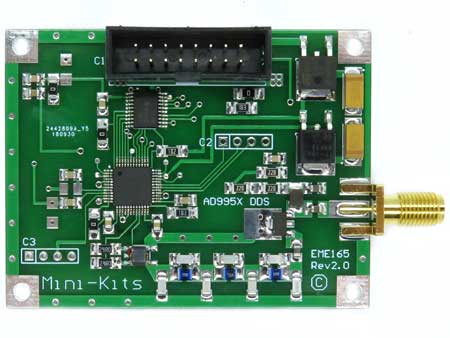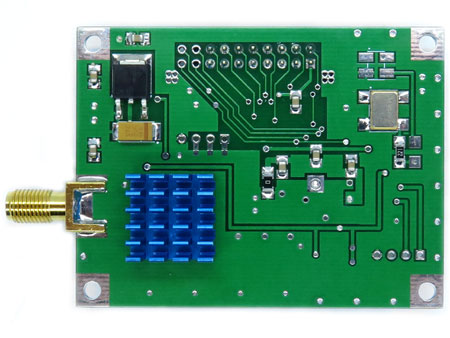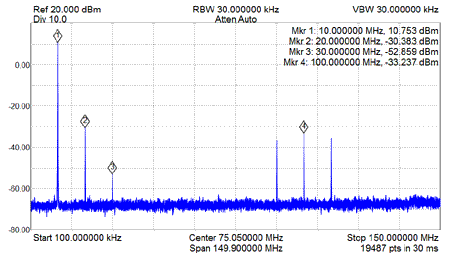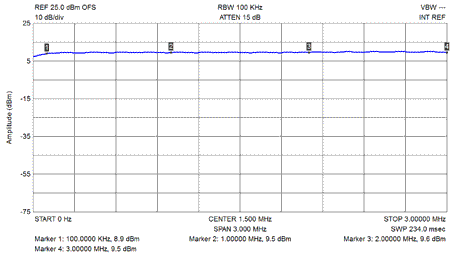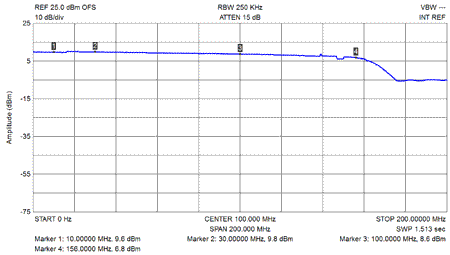EME165-R2 AD995x DDS
- EME165-R2 Description:
Updated! June 2022 - Kit Constructors Alert:
- EME165-R2 Product Notes:
- EME165-R2 Tests:
- Product Faults, Changes and Updates:
Updated! Jan 2025 - Buy A EME165-R2 DDS:
The EME165-R2 PC board was released in November 2018 and is an upgrade to the previous board mainly due to component availability changes, but has also been designed to be easier to construct due to use of larger solder pads for the SMD components.
The EME165-R2 Kit is only available with the Analogue Devices 14 bit 400MHz AD9951, but the PCB does support the AD9952 / 53, and 54 chips. The DDS is suitable as a quality signal generator or VFO for a Transceiver project. The 14 bit A-D in the AD9951 produces much lower spurs compared to the 10 bit AD9850/51 chips that can have some very high -30dBm spurs on some frequencies, so is more ideal for use as a VFO for a high performance receiver or transmitter.
An on board 100MHz 25ppm oscillator uses the x4 DDS multiplier to produce a maximum recommended output frequency of 160MHz. The DDS output uses a 175MHz 7th order elliptic Low Pass Filter, which is used to reduce the aliases and quantization noise from the DAC outputs.
The 3dB RF Bandwidth of the DDS output is around 60kHz to 145MHz, and is mainly limited by the 1:1 Transformer on the DDS DAC outputs along with the coupling capacitors. The Transformer has the benefit of reducing even order harmonics, and produces +3dBm more output power. A high 25dB gain GALI-84 amplifier with an IP3 of +38dBm was chosen as it was able to produce a very clean RF output when under driven. The DAC current RSET was then able to be adjusted to provide a very good Spurious Free Dynamic Range, and drives the high gain GALI-84 device to around 1/2 its capable output power to produce a clean +10dBm output.
The board is compatible to connect 5v logic from a micro controller as it uses a bidirectional translator chip to interface the 5v on the main IDC header connector to 3.3v to suit the DDS logic. The various connections on the header allows the board to be used with many micro controller projects found on the WEB, including the Mini-Kits M1 DDS Controller Kit using the M1-DDS software.
The images below show both sides of the board, click the images for larger views to help with component placement when constructing. The PC board is designed with larger pad sizes to suit hand soldering, so should be easy for constructors that already have experience with soldering SMD.
The PC Board uses plated through holes and separate analogue and digital ground planes, and power supplies to reduce noise. The AD995x requires 3 power supply voltages so the board has two +1.8v regulators for analogue and digital supplies, and a +3.3v regulator for the digital I/O supply. All the chips and regulators run quite cool compared to the older AD985x series DDS chips. >
The standard clock module that is supplied with the basic Kit is a Fox 100MHz 3.3v 25ppm CMOS 5x7mm module. The board also has the provision to fit a 3x2mm size module. Many CMOS clock modules produce far too much output so a resistor is used on the board to reduce the output so that the AD995x is not over driven. The board also has a header connector C3 that is suitable for feeding in your own clock or for extraction of the clock to feed into another AD995x board.
If an AD9954 is used the connector C2 allows interfacing to the AD9954 internal high speed comparator. The comparator can be used to produce a square wave clock from the RF output suitable for switching mixers. Please refer to the AD9954 data sheet.
The AD995x is a +3.3v device and has been interfaced to a 16 Pin
IDC I/O header plug C1 using an TXB0108PWR +3.3v to +5v voltage
translator chip. These chips are much better than using voltage
divider resistors, and allow two way high speed bidirectional data
to be sent between the DDS and Micro controller.
The 16 Pin IDC I/O connector ( C1 ), has the following pin
connections available. The connections in
1 +5v 2 RESET 3 GND 4 I/O UPDATE 5 +12v 6 OSK 7 GND 8 SCLK 9 NC 10 SDO
11 GND 12 SDIO 13 NC 14 PSO 15 NC 16 PS1 17 SYNC IN 18 SYNC_CLK 19 SYNC OUT 20 CS
1/ A problem occurred when the M1-DDS software when first powered up could not recognise the AD995x chip. The fault was traced to a faulty TXB0108P level converter chip on the EME165-R2 DDS board.
2/ No RF output from the DDS board. Check with a sensitive receiver tuned to the DDS output frequency to see if it is actually outputting RF. If it appears to be working and that the RF output is just low go to 4/ below. Check that the 100MHz oscillator module is working. Most problems can be due to bad solder joints on the AD995x and TXB108P chips. Recheck that all pins on the these chips are soldered to the tracks on the board, and that there are no bridges between pins. A good magnifying glass and light is required to clearly see the connections. Sometimes pressing down on the AD995x chip can make the DDS work. If you have developed your own software refer to 5/ below.
3/ No RF output and the DDS not being recognized by the micro-controller board. There were multiple faults which are possibly due to over voltage on the +5 and +12v power supply inputs, or reverse polarity. Replaced the TXB0108 which fixed the connection issue to the DDS. Also found the Gali-84 damaged as it was drawing excessive current, ( 130mA ) and replaced but the RF output was still low. Then found the ETC1-1T-2 Transformer with an open circuit secondary winding. It looked heat damaged possibly due to DC voltage being accidentally connected.
4/ Low RF output from the DDS Board. There are a number of things that can cause this. The most common is, bad solder joints on the I and Q output pins of the AD995x DDS, or one of the chip capacitors in the RF path being cracked. Other things that can cause this is, the 10uH choke not being soldered to the board, or one of the Gali-84 leads being shorted to ground, which turned out to be a solder bridge under the GALI-84 pins. One Kit repair had a dry joint on one of the pins of the T1-1T transformer that connected to the 24ohm resistor.
5/ Using the EME165-R2 DDS board with your own software. Please make sure that you are using the links on the board correctly to suit your software. This has been a common problem experienced by a number of constructors that have written their own software and could not make the board work. The reset line to the AD995x chip will need to be pulled low in software from the micro controller to reset to DDS. Mini-Kits is not able to supply software support on how to write your software to talk to the AD995x.
6/ If you need to drive the DDS board with a 3.3v micro controller, then the 5v supply to pin 19 can be disconnected by cutting the track on the bottom of the board where it goes to pin1 of the C1 header connector. Then connect a wire from the LD1117D T33C 3.3v regulator with a wire to the 0.1uF capacitor under the TXB0108 that connects through the board to pin 19 of the TXB0108.
7/ RF Output not clean with spurious and main output not on the correct frequency. Check the 100MHz clock module to make sure that it is working.

